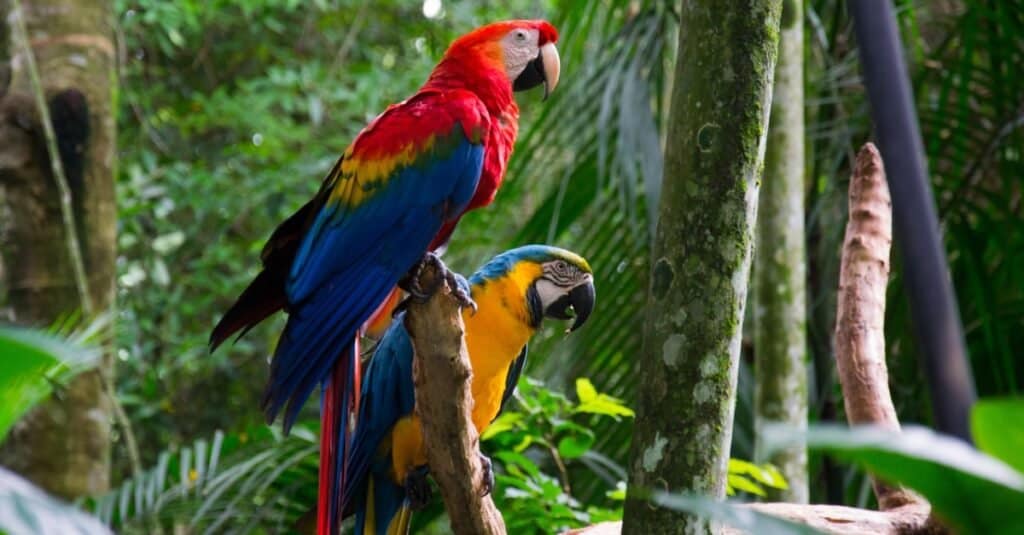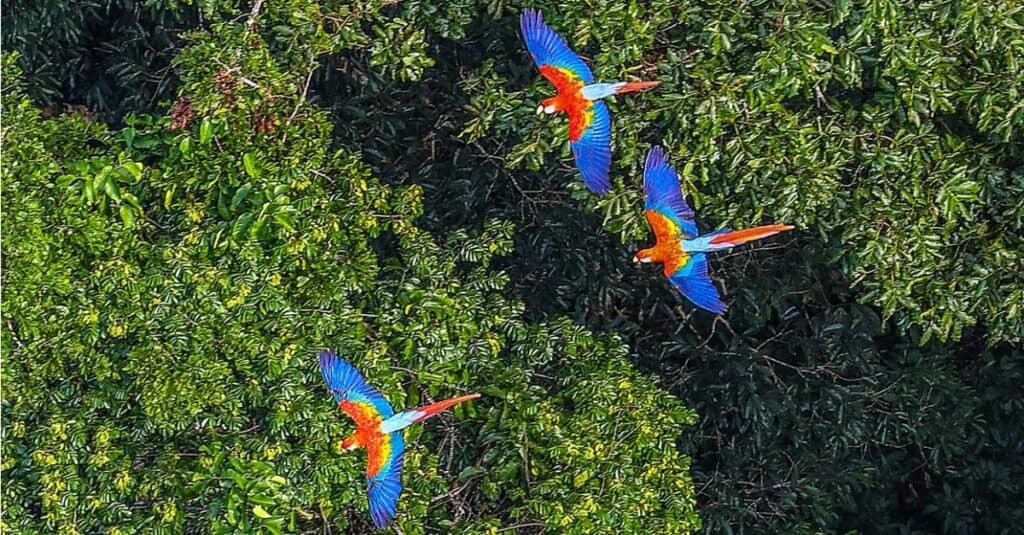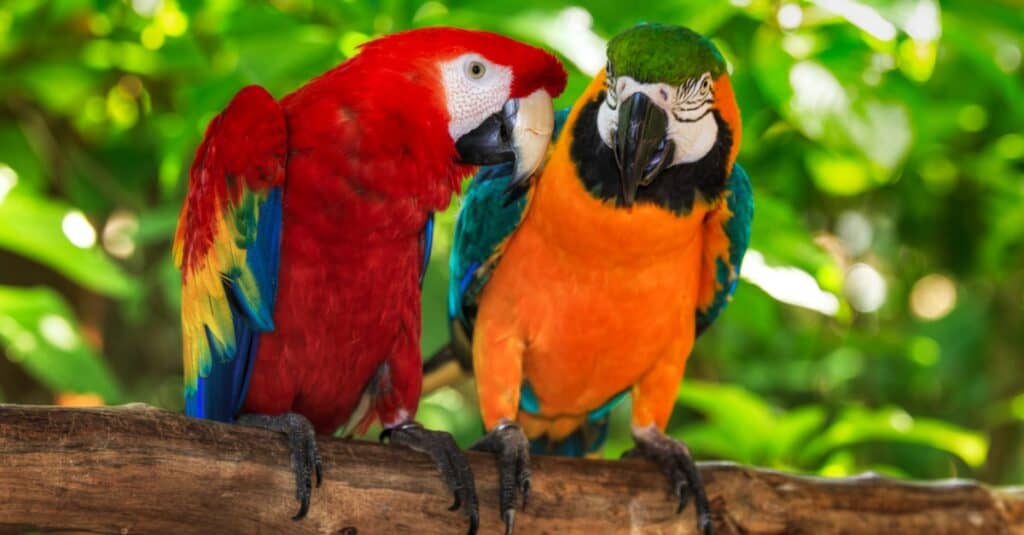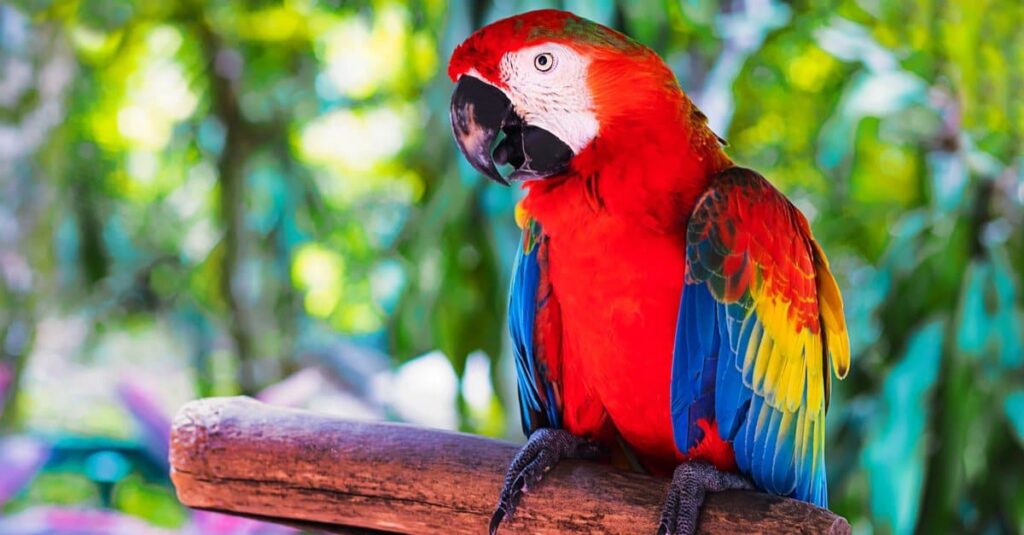Macaws are famous for their bright colors, fearsome beaks, long tails, and screeching voices. They’re native to Central and South America, and live as far north as Mexico. People all over the world keep these flamboyant birds as pets, attracted by their big personalities, ability to mimic human words, and gorgeous plumage. But just what do wild macaws eat? And what do owners feed their pet birds?
Here, we’ll learn about what macaws eat and where they live. Then, we’ll explore one unique, and strange, dietary staple of certain species of macaw. We’ll even learn what macaws feed their chicks, and how long it takes a macaw to reach maturity. Finally, we’ll discover what captive macaws eat and what some of their favorite treats are.
What Do Macaws Eat?

Macaws eat fruits, nuts, green, and insects. They are omnivores
©iStock.com/Gassen
Macaws eat a wide variety of fruits, nuts, vegetables, and insects. They are predominantly omnivorous.
Macaws live primarily in the rainforests of Central and South America, though some species prefer woody grasslands. Because they have such a wide diet, their options for food are extensive. Macaws eat:
- Fruits
- Nuts
- Seeds
- Leaves
- Stems
- Flowers
- Insects
- Nectar.
Macaws will eat many species of flower, which begs the question: do macaws eat orchids? Orchids are one of the few flower species macaws don’t seem to like. They do nibble on the flowers, but don’t consume them entirely.
Though macaws eat primarily nuts, fruits, and greens, they will not say no to a nice insect. Their particular favorites are grasshoppers, roaches, and snails. Some of their favorite fruits include palm fruit and figs. Macaws have also been known to eat many foods that should be toxic to them, we’ll learn more about that later.
What Do Macaws Use Their Beaks For?
Macaws eat nuts and seeds, in fact, nuts are one of their favorite foods. But that doesn’t mean the nuts are easy to get to. Most nuts are encase in very hard shells, that’s where the macaw’s secret weapon comes into play.
Macaws large beaks aren’t just for show; they use them to crack and pry open hard nut casings. Once the macaw has the nut opened up, it uses its incredibly muscular tongue to fish out the nut meat. Because of this specialization, macaws are able to eat nuts that most other animals can’t access.
But that’s not the only method macaws have for gaining access to that hard to reach nut meat. In areas where domestic cattle share territory with macaws, the macaw will actually wait for the cow to consume the hard palm nut, then fish the nut out of the excrement. The macaws save themselves a lot of work this way; the cow’s ruminant stomach completely removes the hard outer casing, making it very easy for the macaw to retrieve the nut meat.
Nuts are an extremely important part of the macaw’s diet because they are very high in fat. Macaws can get by on many foods, but they still need a high fat content in their diet. Macaws will even travel up to 15 miles per day in search of food or good places to forage.
Geophagy: Eating the Earth

In some areas, macaws eat clay to neutralize toxins from other foods.
©iStock.com/RICARDO STUCKERT
Macaws eat foods that are toxic, both to them and to humans. So how do they digest these foods? Well, macaws that eat these toxic foods also eat one other thing; clay.
The practice of eating dirt, or clay, is called geophagy, and macaws are not the only species to do it. Some scientists think the macaws engage in geophagy in order to get enough sodium (high in seaside clay deposits) into their diet. But observation and testing seem to show that the macaws are actually eating dirt to offset the effects of the toxic foods they eat.
Macaws have been observed eating less clay after heavy rains, this is an indication that they are using the clay to neutralize toxins. So, not only do macaws eat foods that are good for them; they also eat toxic foods pared with neutralizing clay.
What Do Macaw Chicks Eat?
Macaw parents usually have 1-4 chicks at a time. The chicks are born with their eyes closed and only a few feathers. They are completely dependent on their parents, both of whom feed them. After a few days, their eyes open, and they begin picking on their weaker nest mates.
It may seem sad, but macaw chicks are competitive, and often only the strongest survive. Parents feed their chicks until they gain full plumage, around three months old, and start flying on their own. The macaw chicks eat whatever the parents bring them, including insects, fruits, nuts, vegetables, and seeds. Depending on the species, it takes 2-10 years for the chicks to reach full maturity.
What Do Pet Macaws Eat?

Pet macaws eat a wide variety of fruits, vegetables, nuts, and seeds.
©iStock.com/dmodlin01
Macaws have long been a popular pet for aviary enthusiasts. People have been keeping them either as pets, or as animals farmed for their feathers, for perhaps thousands of years. Pre-Columbian civilizations like the Inca, Nazca, and Wari’ kept macaws and used their feathers for all many of clothing and textiles.
Today, captive macaws may live over 60 years. But just what do owners feed their long lived avian companions?
Captive macaws eat many fruits, vegetables, nuts, premade bird food, seeds, insects, and even meat. Owners may feed their birds:
- Vegetables: zucchini, sweet potatoes, butternut squash, carrots, corn, spinach, beets, asparagus, bell peppers, broccoli, dandelion greens, pumpkin, artichoke, endive, green beans, and collard greens
- Fruits: bananas, strawberries, berries, star fruit, oranges, kiwis, mangoes, grapes, and dates
- Raw, unsalted nuts: peanuts, macadamia nuts, brazil nuts, pine nuts, almonds, hazelnuts, cashews, pecans, and pistachios
- Seeds: all seeds, but sunflower seeds only sparingly as they have very high fat content
- Meat: captive macaws will eat eggs, fish, and even poultry, though these should be given in moderation
- Condensed bird cakes: premade cakes of seeds, nuts, and fruits that the macaws can pick apart.
What Foods Should Macaws Avoid?

Colored exotic Scarlet Macaw parrot sits on a branch in the tropical forest
©Daria Photostock/Shutterstock.com
While macaws are hearty birds and have a lot of good dietary choices, there are some foods that will not agree with your pet. Foods you should never feed a macaw include:
- Xylitol–This artificial sweetener, found in diet foods like sugarless gum, has been found to cause hypoglycemia, liver damage, and possible death in pets like dogs. While it hasn’t been tested on birds, it’s best to avoid feeding them anything containing this substance.
- Avocado–Persin is an acidic fatty substance found in the leaves of an avocado plant that can cause heart and respiratory issues in birds and sudden death. It’s recommended to avoid this particular fruit, even though we typically eat the inside of avocados.
- Chocolate–Though ultra-tasty, chocolate is toxic to birds as well as many pets, including dogs. It contains theobromine and caffeine, both of which can cause increased heart rate, seizures, diarrhea, vomiting, and even death.
- Caffeine–While humans can handle caffeine (whether or not we should partake is a debate for another day), it has magnified effects on animals like birds, including hyperactivity, increased heart rate, and possible cardiac arrest.
- Fat–Large amounts of fat cause obesity in animals as well as humans, and can also result in high cholesterol and triglycerides.
- Onions/Garlic–Both of these are toxic to birds, damaging the inner linings of the bird’s mouth and esophagus, or causing ulcers, anemia, and weakness.
- Salt–Too much of this substance ingested by birds in the form of salty human snacks can result in dehydration, kidney failure, or death.
- Apple & Pear Seeds or Fruit Pits–These particular items contain trace amounts of cyanide. Apple and pear, minus the seeds, are fine.
Summary of What Macaws Eat
Here’s a recap of the foods that macaws commonly consume in the wild:
| Number | Food |
|---|---|
| 1 | Fruits (e.g. palm fruit, figs) |
| 2 | Nuts |
| 3 | Seeds |
| 4 | Leaves |
| 5 | Stems |
| 6 | Flowers |
| 7 | Insects (e.g. grasshoppers, roaches, snails) |
| 8 | Nectar |
| 9 | Dirt or clay |
| 10 | Vegetables (Fed to pet macaws) |
| 11 | Meat (Fed to pet macaws) |
| 12 | Condensed bird cakes (Fed to pet macaws) |
The photo featured at the top of this post is © iStock.com/FG Trade
Thank you for reading! Have some feedback for us? Contact the AZ Animals editorial team.







